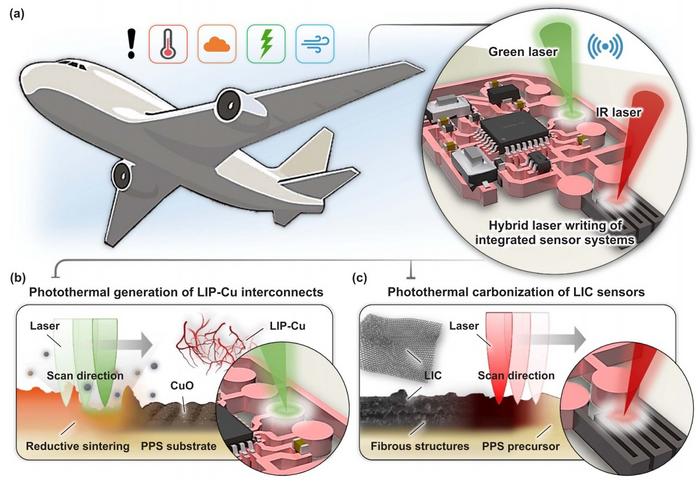
Laser Writing Integrates Sensors on Material to Manage Equipment Safety
HANGZHOU, China, Sept. 13, 2024 — With superior mechanical properties, lightweight features, and the ability to withstand harsh environments, engineering thermoplastics are viewed as highly desirable materials for aerospace, automotive, biomedical, and electronics applications. To improve the safety and extend the service life of engineering thermoplastics, it is necessary to integrate them with sensors that will monitor their structural health and track their environmental parameters.
A hybrid laser direct writing technique, developed by researchers at Zhejiang University, integrates sensor systems directly into engineering thermoplastics by incorporating functional copper (Cu) interconnects, carbon-based temperature sensors, and signal processing components all within one system. The integrated sensor system allows for real-time temperature monitoring over extended periods to ensure optimal performance and reliability of critical equipment.

(a) Schematic of the laser-induced integrated sensor system (LISS) on the surface of engineering thermoplastics applied in aircrafts. The LISS is composed of sensors, conductive interconnects, and signal processing modules. (b) Schematic of laser-induced passivation of copper (LIP-Cu) interconnects for a LISS fabricated by a continuous wave (CW) green laser. (c) Schematic of laser-induced carbon (LIC) sensors for an LISS fabricated by an IR laser. Some figure elements were created using BioRender.com. Courtesy of K. Xu, Z. Cai, H. Luo, X. Lin, G. Yang, H. Xie, S.H. Ko, and H. Yang.
In-situ manufacturing uses various printing techniques to pattern conductive or functional materials. Cu-based inks are cost-effective and have high conductivity, but Cu tends to oxidize easily during and after processing. The researchers recognized that an economical, stable way to make Cu resistant to oxidation would be needed to help them achieve an in-situ system integrating sensors, interconnects, and signal processing components with engineering thermoplastics.
The researchers used a one-step, laser-induced photothermal treatment to build highly durable Cu interconnects and improve the Cu’s oxidation resistance at high temperatures. Using a continuous wave laser, they created functional Cu interconnects through photothermal reduction and passivation of copper oxide (CuO). Using an IR laser, the team formed laser-induced carbon sensors from the thermoplastic substrate. The IR laser enabled the carbonization of the thermoplastic, which led to highly stable temperature sensors.
Through the photothermal treatment, the researchers simultaneously achieved reductive sintering and passivated modification of the functional Cu, giving the Cu intrinsic antioxidative capability and durability at temperatures up to 170 °C without additional encapsulations.
The researchers tested the durability and performance of the integrated sensor system under various environmental conditions, interfacing it with signal processing modules and using it for long-term and real-time temperature monitoring.
The in-situ, hybrid, laser-induced, integrated sensor system could offer a solution to long-term and real-time monitoring of temperature and environmental factors such as structural health and fault diagnosis to industries that use engineering thermoplastics. For example, the integrated sensor system could support the growing demand for lightweight, durable electronics in advanced equipment for the aerospace, automotive, high-speed rail, and medical device industries.
The team plans to expand the capabilities of the system to incorporate additional sensing units for parameters like pressure, strain, and humidity. The team’s goal is to develop advanced manufacturing techniques to enable high-quality conformal electronics on curved surfaces and move beyond the current limitations of planar surfaces. As the researchers continue to refine this technology, they hope to explore the use of multi-material and multi-axis direct writing to develop high-quality conformal manufacturing on arbitrary curved surfaces.
“Our research mainly includes the development of innovative fabrication techniques, multifunctional devices, as well as system level applications,” professor Kaichen Xu said. “Based on the principle of laser and matter interactions, we focus on manufacturing of versatile devices mainly using hybrid (ultrafast) laser processing platforms, which are endowed with multitasking features.”
The research was published in the International Journal of Extreme Manufacturing (www.doi.org/10.1088/2631-7990/ad6aae).
Published: September 2024